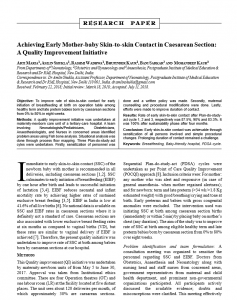
Immediate to early skin-to-skin contact (SSC) of the newborn baby with mother is recommended in all deliveries, including caesarean sections. SSC culminates to early initiation of breastfeeding (EIBF) by one hour after birth and leads to successful initiation of lactation. EIBF reduces neonatal and infant mortality rate by achieving higher rates of sustained exclusive breast feeding. EIBF in India is low at 41.6% of all live births. No national data is available on SSC and EIBF rates in caesarean sections where it is definitely not a standard of care. Caesarean sections are also associated with lower exclusive breast feeding rates at six months as compared to vaginal births (VD), but these rates are similar to vaginal delivery if EIBF is achieved. Therefore, the present quality initiative was undertaken to improve rate of SSC at birth among babies born by caesarean sections at our hospital.
—
This special issue of Indian Pediatrics (September 2018; Volume 55: Number 9) highlights mechanisms that can support health care providers in using various quality improvement (QI) approaches and showcases some of the improvement projects undertaken in India by different teams.
The USAID ASSIST Project started working in India in September 2013; initially working directly with districts and facilities to help them learn how to use QI approaches to save lives. This work went well and the staff in these facilities were able to reduce perinatal mortality by 15% over 18 months. During this time, we met great partners from important organizations and institutions across India.
These institutions are now leading a growing movement to help more people apply QI methods to deliver care that prevents harm, improves outcomes, and meets the needs of the people receiving it through their own networks using domestic funding; continuing these lifesaving efforts after ASSIST technical support has ended.
The supplement shows important results of the ongoing QI work in these networks and shows how domestic QI networks, earlier supported by ASSIST, are now independently supporting and spreading the use of QI methods to provide better care.